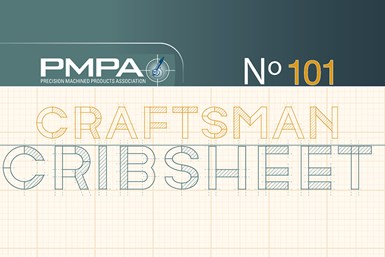Craftsman Cribsheet No. 101: Audit Certifications
Quality documentation can aid in problem-solving, but only if it is complete.
#basics #pmpa

Just because a document claims to be a ‘certification’ doesn’t mean it actually contains the information that you need to have confidence in the material that you buy and then further warrant to your customer.
A situation arose where a PMPA member had secured four different releases of a steel item from a steel service center. The steel from three of the releases performed fine in process. One did not. Material certifications lacked several key facts that could have helped provide an explanation:
- No ASTM specification. Without such a specification, the document isn’t certifying to an agency specification or standard. The document did caption a purchase order, but did the P.O. actually capture all the requirements? The “certification” was actually stating that the results are true and correct copy of records — including chemistry as reported by original (but unknown) supplier.
- Full chemistry reporting only carbon, manganese, phosphorus, sulfur, silicon and lead may seem to cover all chemical elements of interest, as long as the material runs well in process. However, when trying to investigate differences between different heats, the full chemistry could have indicated different origin of the material prior to the processing and purchase by the service center. A difference in copper content or other residual elements (nickel, chrome, molybdenum) could have shown a difference between supplier processes ahead of the service center. This could have also implied other elements that might be different as a result of different process — such as nitrogen — which may have had an effect on the shop’s process.
- No reduction ratios reported. The reduction ratio might have shown us obvious differences between lots indicating process differences/mill supplier differences which could indicate a need to adjust the process. No reduction ratio, no insight as to the possible similarities or differences in the amount of work in process between the different batches of steel provided.
- Unexplained tensile test results. The material for all four releases was ordered to a single specific decimal size, but the tensile properties that were reported under the heading of “Physical” included the following: Release #1, 17/32-78,170 (no mention of units); Release #2, 17/32-71,800; Release #3, ½-70,347; and Release #4, ½-80,000. However, under another field labeled “Other,” the documents reported “Drawn Tensile, PSIs” for release #1 of 1A-99,770, 1B- 99,770; Release #2, 1A- 93,445; Release #3, 81,987; Release #4, 89,300. Difference of tensile properties between the different values from the two reported on each cert ranged from over 30.1% for release #2 tensile to 11.6% in tensile strength for the release in question. That amount of variation generates questions.
- No identification of actual mill source. Traceability is crucial, and often mandated by various Buy American rules from the federal government. No assurance that the material was of domestic origin. The differences in heat number formats did suggest different suppliers — 10 numeric digits with the same first digit for two releases; one nine-digit heat number with first two digits being alpha, remainder numeric for the third; and the final release having a heat number of only nine numeric digits. Likely to have been two — perhaps three — different original hot roll sources.
Have you audited the information that your suppliers are providing to you on their “certifications/test reports?” Just because a document claims to be a ‘certification’ doesn’t mean it actually contains the information that you need to have confidence in the material that you buy and then further warrant to your customer. Audit your “certifications!”
RELATED CONTENT
-
4 Reasons Work Instructions are Useful
What is the definition of work instructions? Work instructions are created to guide workers in four key quality areas: training, reference, problem solving and continuous improvement. Use these four reasons to write useful work instructions.
-
Bar Feeder Basics
Some primary factors are often overlooked when considering how to justify the implementation of a bar feeder for turning operations.
-
Understanding CNC Collet Chucks
Workholding for turning is usually fairly basic: The selection comes down to chucks or collets. This article looks at when to consider the collet chuck and what kind might be best for a given application.


